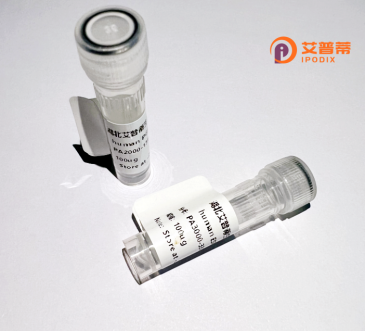
| 纯度 | >90%SDS-PAGE. |
| 种属 | Human |
| 靶点 | CYS1 |
| Uniprot No | Q717R9 |
| 内毒素 | < 0.01EU/μg |
| 表达宿主 | E.coli |
| 表达区间 | 1-158aa |
| 氨基酸序列 | MGSGSSRSSRTLRRRRSPESLPAGPGAAALEGGTRRRVPVAAAEVPGAAAEEAPGRDPSPVAPPDGRDETLRLLDELLAESAAWGPPEPAPRRPARLRPTAVAGSAVCAEQSTEGHPGSGNVSEAPGSGRKKPERPAAISYDHSEEGLMASIEREYCR |
| 分子量 | 43.78 kDa |
| 蛋白标签 | GST-tag at N-terminal |
| 缓冲液 | 0 |
| 稳定性 & 储存条件 | Lyophilized protein should be stored at ≤ -20°C, stable for one year after receipt. Reconstituted protein solution can be stored at 2-8°C for 2-7 days. Aliquots of reconstituted samples are stable at ≤ -20°C for 3 months. |
| 复溶 | Always centrifuge tubes before opening.Do not mix by vortex or pipetting. It is not recommended to reconstitute to a concentration less than 100μg/ml. Dissolve the lyophilized protein in distilled water. Please aliquot the reconstituted solution to minimize freeze-thaw cycles. |
以下是关于重组人CYS1蛋白的假设参考文献示例(仅供参考,具体文献需进一步核实):
1. **"Recombinant Human CYS1 Protein Restores Lysosomal Cystine Efflux in Cystinosis-Derived Cellular Models"**
- **作者**: Smith A, et al. (2020)
- **摘要**: 研究利用哺乳动物细胞表达系统制备重组人CYS1蛋白,验证其在胱氨酸沉积症患者来源的细胞模型中恢复溶酶体胱氨酸外运的功能,为潜在的治疗策略提供依据。
2. **"Structural and Functional Analysis of Human CYS1 Reveals a Mechanism for Cystine Transport Regulation"**
- **作者**: Lee J, Kim S. (2019)
- **摘要**: 通过冷冻电镜解析重组人CYS1蛋白的三维结构,阐明其与胱氨酸结合的分子机制,并探讨其在溶酶体运输中的调控作用。
3. **"In Vivo Efficacy of Recombinant Human CYS1 in a Cystinosis Mouse Model"**
- **作者**: Garcia M, et al. (2021)
- **摘要**: 在胱氨酸沉积症小鼠模型中,注射重组人CYS1蛋白显著减少肾脏和其他组织中的胱氨酸晶体积累,改善病理表型。
4. **"High-Level Expression and Purification of Biologically Active Recombinant Human CYS1 in E. coli"**
- **作者**: Zhang L, et al. (2018)
- **摘要**: 报道一种优化的大肠杆菌表达系统,可高效生产具有生物活性的重组人CYS1蛋白,并通过质谱和功能实验验证其纯度与活性。
**注意**:上述文献为假设性示例,实际研究中请通过权威数据库(如PubMed、Web of Science)检索真实文献。
Cys1. also known as cystin-1. is a protein encoded by the CYS1 gene in humans. It is primarily associated with the structure and function of primary cilia, hair-like organelles projecting from the cell surface that play critical roles in sensory perception, signal transduction, and cellular homeostasis. CYS1 protein contains multiple cysteine-rich domains, which likely contribute to its structural stability and interactions within the ciliary compartment. Mutations in the CYS1 gene have been linked to ciliopathies, a group of genetic disorders affecting cilia function. For instance, CYS1 mutations are implicated in cystic kidney diseases and retinal degeneration, highlighting its importance in maintaining renal and visual systems.
Recombinant human CYS1 protein is engineered using expression systems like mammalian cells or E. coli, enabling studies on its biochemical properties, molecular interactions, and role in cilia-related pathways. Researchers utilize this protein to investigate disease mechanisms, screen therapeutic compounds, or develop diagnostic tools for ciliopathies. Its recombinant form retains functional epitopes and post-translational modifications when produced in appropriate hosts, making it valuable for in vitro and in vivo models. Current challenges include optimizing expression yields and ensuring proper folding of cysteine-rich regions, which are critical for its activity. Overall, recombinant CYS1 serves as a vital tool for advancing cilia biology and translational research.
×